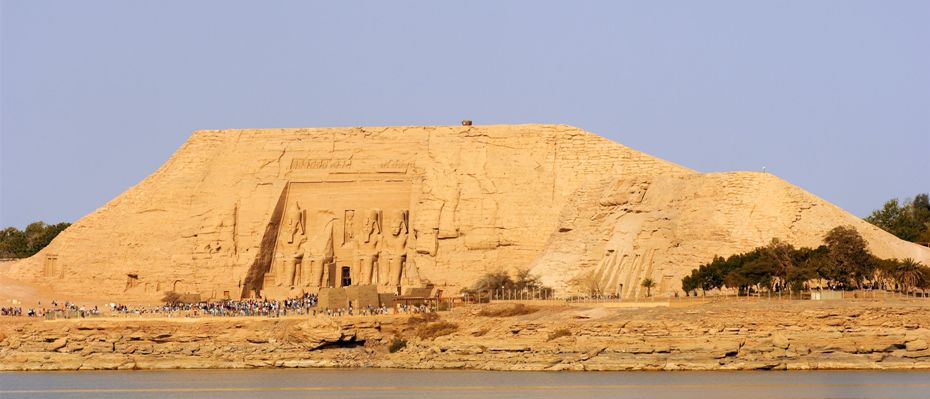 | GIZA, Egypt — In front of the Giza Plateau's Great Pyramids and Sphinx, tourists ride colorfully decorated camels or horses led by Egyptian boys.
Tour buses lumber by on a dusty road lined with souvenir shops selling gold and silver cartouches, painted papyrus, and statuettes of ancient Egyptian gods, goddesses and rulers.
The tumultuous years since Egypt's 2011 revolution devastated shopkeepers, who have worked in tourism here for generations. Five months ago, tour guides sat on the stoops of empty stores, praying for tourists who rarely came.
Now “business is really picking up,” said Abdullah Nasr, 39, a guide for Guardian Travels, which specializes in metaphysical and spiritual tours. “We feel like our country is back.”
“These days are good,” agreed Kamal Ali, who works in the family-owned company's souvenir shop. “It still hasn't reached the levels of tourists we had in 2009, 2010, but it is good. The security situation is better now.”
Giza's pyramids — the only wonders of the ancient world still standing — have attracted awed visitors for centuries. But tourism evaporated because of the bloody revolution and last year's bloodier ouster of Islamist President Mohamed Morsy and his Muslim Brotherhood-led regime.
Tomb raiders and antiquity thieves looted many ancient sites where security had melted.
Former army chief Abdel Fatah al-Sisi won the presidency in May on a promise to restore stability. Not surprisingly, the tourism-dependent Gizan village of Nazlet al Samman strongly favored him.
That support has stiffened with the insurgency in Egypt's Sinai, where the Ansar Beit al Maqdis terror group swore allegiance to ISIS, and growing terrorist attacks across the country.
“Most Egyptians want to live in peace, work and watch football — maybe date, that is all,” Nasr said. “When the Brotherhood came to power, it was like someone stealing your identity, your culture. It was personal.”
One Islamist, he recalled, condemned the pyramids and the Sphinx as idols and “wanted to destroy (them) … wanted to destroy Egypt and make it like Afghanistan.”
“Now we feel safe. Anytime I have to go away for work, I dream of when I will come back to sit and drink tea and look at the pyramids.”
Guardian Travels customers often “meditate to bring peace,” Nasr explained. “They believe that Egypt is the center of the world. So if there is peace here, it will spread throughout the world.”
Marty Pannin, 37, was one of those meditating recently in the Great Pyramid Cheops.
“It was phenomenal,” said the former Australian pilot.
Recent terrorist attacks in the Sinai did not faze him.
“No, I wasn't afraid,” he said. “We all have our own vortex going on.”
The Egyptian government is keen to re-establish tourism, a leading source of hard currency.
Last week, experts finished a four-year restoration of the Sphinx and its courtyard, and a three-year restoration of the smallest pyramid, Menkaure. Prime Minister Ibrahim Mahlab and Antiquities Minister Mamdouh al Damaty attended a chaotic opening for local and foreign press.
Carved from a single limestone slab, the Sphinx has a lion's body and a man's face. Squatting in a quarry below Giza's pyramids, the mythical creature is the world's largest monolith: 66 feet tall, 241 feet long, 63 feet wide.
“Part of the chest of the Sphinx was weak limestone,” said Kamal Wahid, director-general of Giza's antiquities. “We removed a small part … and put in a new one. It is a normal and routine restoration.”
Yet all is not peaceful here.
Wahid, who oversees antiquities in the Sakkara andDahshour pyramid complexes, said work will raze 50 homes along the Cheops causeway and a nearby temple — to the dismay of homeowners.
A committee of six ministries is developing a plan for the displaced, he said.
“They will move them to new houses not far away. … We will find for them a place to sell their products for the tourists.”
In the village of Nazlet al Samman, Nasr stands on the rooftop of Guardian Travels guesthouse overlooking the pyramids and the Sphinx; its 11 guest rooms are full.
He pointed to the condemned houses, some with signs declaring: “No to relocation, yes to development.”
“Development would be better,” he said. “Removing them will be a mistake.” | | |